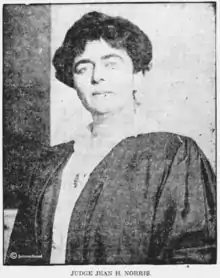Jean H. Norris
Jean Hortense Norris (born January 25, 1877 – died September 7, 1955) was an American judge, the first woman magistrate in New York City. She was appointed to the bench in 1919, but disbarred in 1931, for judicial malfeasance.


Early life
Jean Hortense Noonan was from Brooklyn, New York, the daughter of John Giles Noonan and Maria Theresa Ford Noonan.[1] Her father was a Union veteran of the American Civil War. She attended the Dominican Convent High School and Brooklyn Girls' High School. She earned law degrees from New York University in 1909 (LL.B.) and 1911 (LL.M.).[2][3]
Career
Norris was part of the Tammany Hall political organization, working alongside judge George Washington Olvany. She was active in the suffrage movement in the 1910s. She represented married women teachers who appealed their school boards' denial of maternity leave or continued employment.[4][5] She also wrote about the laws concerning working conditions for women.[6][7] She served as president of the National Women Lawyers' Association in 1914.[8]
Norris became the first woman judge in New York in 1919.[9] Her first appointment to the bench was to fill a temporary opening, and then in 1920[10] moving into permanent positions on the Court of Domestic Relations and the Women's Day Court.[11] She was elected president of the New York State Federation of Business and Professional Women's Clubs.[12] In 1923 she went on a world tour, to learn about how women offenders were handled in different court systems.[13][14]
The Hofstadter Committee[15] found that Norris was working in collaboration with the police, falsifying court records and profiting from the sale of bail bonds.[16] She also endorsed Fleischmann's Yeast as a health supplement, wearing her judge's robes in advertisements, a violation of professional ethics. Five judges of the Appellate Division of the New York State Supreme Court ruled that she was guilty on five counts of judicial malfeasance.[17] She was removed from the bench and disbarred in 1931.[18] She unsuccessfully appealed her disbarment later that year.[19]
Norris was known to be harsh in prostitution cases and cases involving black women. In over five thousand cases, "and especially in prostitution-related arrests of black women, Norris handed down 40 percent more convictions than other magistrates."[20] This is exemplified by her decision to imprison dancer Mabel Hampton in Bedford Hills in 1924, who did not engage in prostitution and has described being framed in a setup by a police informant.[20]
In 1933, the former magistrate sued the producers of a play titled Four O'Clock, because it included a corrupt woman judge that she believed was a damaging reference to her own legal troubles.[21][22] The producers agreed to change the character's gender to settle the suit.[23] In 1936 her essay "The Marriage Problem" appeared in American newspapers, predicting a constitutional amendment to make marriage and divorce laws more uniform across the United States.[24]
Personal life
Jean Noonan married Thomas H. Norris in 1897, and was widowed when he died from a self-inflicted gunshot wound, apparently by accident, in 1899.[25]
Death
Jean Hortense Norris died at the age of 78 on September 7, 1955, having lived the last 20 years of her life in relative obscurity. She was buried in Holy Cross Cemetery, Brooklyn alongside her father John G. Noonan (d.1894).[26]
References
- John William Leonard, ed., Woman's Who's who of America (American Commonwealth Printing 1914): 601.
- "Mrs. Norris Ousted as Unfit for Bench; Guilty on 5 Charges" New York Times (June 26, 1931): 1. via ProQuest
- "Jean Norris Defends Bonding House Link; Severe in Vice Cases" New York Times (February 12, 1931): 1. via ProQuest
- Department Reports of the State of New York (J. B. Lyon 1915): 631-636.
- "Stand Taken by Women Lawyers on the Subject of Married Women Teachers" Women Lawyers' Journal (April 1914): 52.
- Jean H. Norris, "United States Supreme Court on the Question of Working Hours for Women" Women Lawyers' Journal (March 1914): 42.
- Jean H. Norris, "Oregon Law Fixing Wage Rate for Women Declared Constitutional" Women Lawyers' Journal (May 1914): 58.
- "Lawyers at the Convention" Women Lawyers' Journal (October–December 1919): 2.
- "Woman Sits on Bench" New York Times (October 29, 1919): 13. via ProQuest
- "Woman Succeeds Curran" New York Times (January 3, 1920): 15. via ProQuest
- "National Meeting of Women Lawyers" Women Lawyers' Journal (April 1921): 21.
- "Rivalry at Club Election" New York Times (May 8, 1921): 18. via ProQuest
- "Magistrate Jean Norris Will Tour the World to Learn how Women Offenders are Treated" New York Times (January 23, 1923): 23. via ProQuest
- "Woman Jurist is Girdling Globe to Study Courts" Honolulu Star-Bulletin (May 7, 1923): 4. via Newspapers.com

- "Acts Misconstrued, Judge Norris Says, Fighting Removal" New York Times (June 4, 1931): 1. via ProQuest
- "Mrs. Norris Admits She convicted Girl without Evidence" New York Times (June 25, 1931): 1. via ProQuest
- "Norris Ousted" Time (July 6, 1931).
- Herbert Mitgang, The Man Who Rode the Tiger: The Life and Times of Judge Samuel Seabury (Fordham University Press 1996): 191-195. ISBN 9780823217229
- "Mrs. Norris Fights to Appeal Removal" New York Times (August 28, 1931): 2. via ProQuest
- Ryan, Hugh (2019-03-05). When Brooklyn Was Queer: A History. St. Martin's Publishing Group. p. 113. ISBN 978-1-250-16992-1.
- "Producers of Play Sued by Jean Norris" New York Times (February 19, 1933): 25. via ProQuest
- "Reply in Mrs. Norris' Suit" New York Times (February 21, 1933): 17. via ProQuest
- "'Four O'Clock' Suit Settled" New York Times (May 24, 1933): 24. via ProQuest
- Jean H. Norris, "The Marriage Problem" Murray Eagle (January 2, 1936): 6. via Newspapers.com

- "The Revolver was Loaded" Brooklyn Daily Eagle (May 9, 1899): 16. via Newspapers.com

- Mae C. Quinn "Fallen Woman Further (Re)Framed:Jewels and Travels, Tragedies and Secrets, Judge Jean Hortense Norris" Kansas Law Review (2018).

External links
- A photograph of Jean H. Norris from the 1910s, from the Bain News Service collection, Library of Congress.